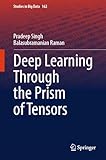Deep learning through the prism of tensors
Material type: TextPublication details: Cham Springer 2024Description: xxv, 610 pISBN:
TextPublication details: Cham Springer 2024Description: xxv, 610 pISBN: - 9789819780181
- 006.31 SIN
| Item type | Current library | Collection | Call number | Copy number | Status | Date due | Barcode | |
|---|---|---|---|---|---|---|---|---|
 Book
Book
|
Indian Institute of Management LRC General Stacks | IT & Decisions Sciences | 006.31 SIN (Browse shelf(Opens below)) | 1 | Available | 009081 |
Table of contents:
Front Matter
Pages i-xxv
Download chapter PDF
A Tensorial Perspective to Deep Learning
Pradeep Singh, Balasubramanian Raman
Pages 1-27
The Algebra and Geometry of Deep Learning
Pradeep Singh, Balasubramanian Raman
Pages 29-70
Building Blocks
Pradeep Singh, Balasubramanian Raman
Pages 71-132
Journey into Convolutions
Pradeep Singh, Balasubramanian Raman
Pages 133-231
Modeling Temporal Data
Pradeep Singh, Balasubramanian Raman
Pages 233-301
Transformer Architectures
Pradeep Singh, Balasubramanian Raman
Pages 303-367
Attention Mechanisms Beyond Transformers
Pradeep Singh, Balasubramanian Raman
Pages 369-421
Graph Neural Networks: Extending Deep Learning to Graphs
Pradeep Singh, Balasubramanian Raman
Pages 423-482
Self-supervised and Unsupervised Learning in Deep Learning
Pradeep Singh, Balasubramanian Raman
Pages 483-540
Learning Representations via Autoencoders and Generative Models
Pradeep Singh, Balasubramanian Raman
Pages 541-585
Recent Advances and Future Perspectives
Pradeep Singh, Balasubramanian Raman
Pages 587-605
[https://link.springer.com/book/10.1007/978-981-97-8019-8]
In the rapidly evolving field of artificial intelligence, this book serves as a crucial resource for understanding the mathematical foundations of AI. It explores the intricate world of tensors, the fundamental elements powering today's advanced deep learning models. Combining theoretical depth with practical insights, the text navigates the complex landscape of tensor calculus, guiding readers to master the principles and applications of tensors in AI. From the basics of tensor algebra and geometry to the sophisticated architectures of neural networks, including multi-layer perceptrons, convolutional, recurrent, and transformer models, this book provides a comprehensive examination of the mechanisms driving modern AI innovations. It delves into the specifics of autoencoders, generative models, and geometric interpretations, offering a fresh perspective on the complex, high-dimensional spaces traversed by deep learning technologies. Concluding with a forward-looking view, the book addresses the latest advancements and speculates on the future directions of AI research, preparing readers to contribute to or navigate the next wave of innovations in the field. Designed for academics, researchers, and industry professionals, it serves as both an essential textbook for graduate and postgraduate students and a valuable reference for experts in the field. With its rigorous approach to the mathematical frameworks of AI and a strong focus on practical applications, this book bridges the gap between theoretical research and real-world implementation, making it an indispensable guide in the realm of artificial intelligence.
(https://link.springer.com/book/10.1007/978-981-97-8019-8)
There are no comments on this title.

